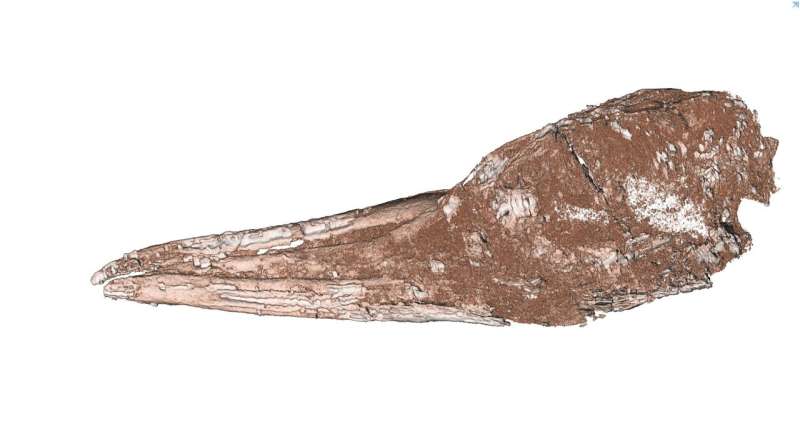This article has been reviewed according to Science X's editorial process and policies. Editors have highlighted the following attributes while ensuring the content's credibility:
fact-checked
trusted source
proofread
New fossil species suggests tropicbirds originated in Zealandia

A team of paleontologists from the University of Canterbury has discovered a remarkably intact fossil of one of the earliest ancestors of a group of birds now restricted to the tropics. Tropicbirds, now represented by only three living species, have a long fossil record spanning at least 62.5 million years, with the oldest described species being Clymenoptilon novaezealandicum, or Zealandian Tropicbird.
The specimen, boasting a nearly complete skull, wing, and pelvis among other elements, was collected from the Waipara Greensand, North Canterbury, and is estimated to be around 62 million years old. It is the second tropicbird found in the Waipara Greensand (the first one was a smaller, unnamed specimen described in 2016).
The Zealandian Tropicbird has features that distinguish it from all other known fossil tropicbirds and suggest it was, evolutionarily speaking, an ancestral form of tropicbird. Features of the skull, wing, and pelvis suggest it had different feeding/foraging habits from living and other extinct tropicbirds, but because the specimen has no legs, it is not possible to get a complete picture of its mode of life.
The find has been published as an article, "Partial skeleton from the Paleocene of New Zealand illuminates the early evolutionary history of the Phaethontiformes (tropicbirds)," in Alcheringa: An Australasian Journal of Palaeontology.
The age (ca. 62 million years) and ancestral characteristics of this newly described species suggest that tropicbirds may have originated in the Southern Hemisphere—up until now all other fossil species had been known from the Northern Hemisphere only.
The presence of a second, smaller, species of tropicbird in the Waipara Greensand, together with that of a primitive bony-toothed bird, and multiple species of penguin, indicate that Zealandian shores were a hub for seabird diversification following the mass extinction event that famously caused the extinction of the dinosaurs 66 million years ago.
Leigh Love, who first only found its skull but fortunately, a month later, also the rest of the specimen, discovered the Zealandian Tropicbird. His then 10-year-old son David helped him retrieve it.
"He was 10 years old at the time and very keen to join me on some of my fossil hunting trips into the Waipara," said Love.
"On this occasion when we found the bones, he said he was both surprised and amazed that we had found a flying bird. For me it has been great watching a child's face light up as a result of finding rare creatures preserved from our distant past."
More information: Gerald Mayr et al, Partial skeleton from the Paleocene of New Zealand illuminates the early evolutionary history of the Phaethontiformes (tropicbirds), Alcheringa: An Australasian Journal of Palaeontology (2023). DOI: 10.1080/03115518.2023.2246528
Provided by University of Canterbury





















